INSTITUT SUPERIEUR D'ANTHROPOLOGIE
INSTITUTE OF ANTHROPOLOGY
ONLINE COURSES / COURS A DISTANCE
FALL TERM : OCTOBER 2015
REGISTER NOW
INDE – 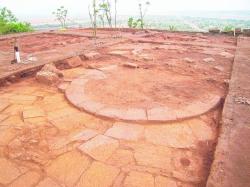 Aragada - Archaeologists have stumbled upon a Buddhist stup atop Aragada, a hill on the city outskirts, which could date back to as early as the first century. The hill, about 5km from Jatni, also has a double-storey cave temple from the seventh or eighth century. The culture department's archaeologists, who are in the preliminary stage of excavation, have found the distinctly carved stup after removing layers of soil. It lay buried under an earthen mound covered with wild bushes. Odisha Institute of Maritime and South East Asian Studies secretary Sunil Kumar Patnaik said: "After a month's work, we have found scattered architectural remains and a circularstup on the hilltop. Its full shape will emerge after a fortnight or so." Patnaik, a well-known Buddhist scholar, said the stup's construction style and the type of stones used showed it was much older than the two-storey cave temple located nearby. He said it could date back to the first century. Historians are also studying the correlation between the locations of Sisupalgarh, Dhauli hills, Biswanath hill and Aragada as they appear to form a cluster. They think that there might have been a sizeable Buddhist population in and around Bhubaneswar as the infamous Kalinga War (261BC) was fought on the banks of the Daya river near the Dhauli hills. Patnaik hoped that the excavations at Aragada would provide fresh insight into the antiquity of Bhubaneswar and Puri.
Aragada - Archaeologists have stumbled upon a Buddhist stup atop Aragada, a hill on the city outskirts, which could date back to as early as the first century. The hill, about 5km from Jatni, also has a double-storey cave temple from the seventh or eighth century. The culture department's archaeologists, who are in the preliminary stage of excavation, have found the distinctly carved stup after removing layers of soil. It lay buried under an earthen mound covered with wild bushes. Odisha Institute of Maritime and South East Asian Studies secretary Sunil Kumar Patnaik said: "After a month's work, we have found scattered architectural remains and a circularstup on the hilltop. Its full shape will emerge after a fortnight or so." Patnaik, a well-known Buddhist scholar, said the stup's construction style and the type of stones used showed it was much older than the two-storey cave temple located nearby. He said it could date back to the first century. Historians are also studying the correlation between the locations of Sisupalgarh, Dhauli hills, Biswanath hill and Aragada as they appear to form a cluster. They think that there might have been a sizeable Buddhist population in and around Bhubaneswar as the infamous Kalinga War (261BC) was fought on the banks of the Daya river near the Dhauli hills. Patnaik hoped that the excavations at Aragada would provide fresh insight into the antiquity of Bhubaneswar and Puri.
http://www.telegraphindia.com/1150503/jsp/frontpage/story_17941.jsp#.VUXO4d-c08o
USA - Coon Valley - The Mississippi Valley Archaeology Center (MVAC) hosted a volunteer field survey at the Norskedalen Heritage Center near Coon Valley. Volunteers joined archaeologists from MVAC to pace local fields looking for rock artifacts, pottery, and coal left by Native Americans and early European settlers. Mississippi Valley Archaeology Center Senior Research Associate Connie Arzigian said. Arzigian said that as farmers plow their fields, artifacts are churned up as the dirt is turned, leaving them near the surface for volunteers to find. Saturday's field survey found dozens of artifacts, some of the around 2,000 years old. Arzigian said there are specific things archaeologists look for to tell artifacts from rocks, like sharp edges and areas where rock has been chipped away.
http://www.wxow.com/story/28962004/2015/05/02/volunteers-look-for-local-history-in-archaeological-field-survey
TURQUIE – 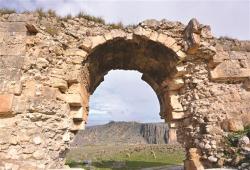 Anavarza -Restoration works have been continuing to bring the triumphal arch [of Anavarza] to tourism. Most parts of the arch are still strong. The restoration process will begin soon. The monumental city gate, which is a legacy from the ancient world, will regain its original [glory] within a year,” said Çukurova University academic Fatih Gülşen, who is acting as a scientific consultant on excavations in the ancient city of Anavarza.The arch, now located in the province’s Dilekkaya village, was 22.5 meters wide and 10.5 meters high, with a wall thickness of 5.60 meters, he said.Gülşen said after their victory against the Persians in the third century B.C., the Romans built the arch in Anavarza, the military camp city of the Roman Empire in the east. Gülşen said 502 block stones that had fallen from the arch would be placed in their original places. “The monumental gate, which is an artistic wonder, had three arches,” he said. “Some parts of the western arch collapsed but the main arch in the middle and the one in the east still survive. We finished the drawings of the collapsed and missing blocks. The pieces that fell from the gate have been numbered and have undergone laser scanning. We will put them in their own places during the restoration. The triumphal arch has high-quality workmanship; smooth square lime, marble and granite stones were used in the construction. Tougher and high-quality limestone was used in its curves. It is a huge and unique structure decorated with Corinthian heads, columns, pilasters [rectangular columns] and niches. Because of these features, it is the only one in the region that we call Çukurova today, and one of the few monumental city gates within the borders of Turkey.”
Anavarza -Restoration works have been continuing to bring the triumphal arch [of Anavarza] to tourism. Most parts of the arch are still strong. The restoration process will begin soon. The monumental city gate, which is a legacy from the ancient world, will regain its original [glory] within a year,” said Çukurova University academic Fatih Gülşen, who is acting as a scientific consultant on excavations in the ancient city of Anavarza.The arch, now located in the province’s Dilekkaya village, was 22.5 meters wide and 10.5 meters high, with a wall thickness of 5.60 meters, he said.Gülşen said after their victory against the Persians in the third century B.C., the Romans built the arch in Anavarza, the military camp city of the Roman Empire in the east. Gülşen said 502 block stones that had fallen from the arch would be placed in their original places. “The monumental gate, which is an artistic wonder, had three arches,” he said. “Some parts of the western arch collapsed but the main arch in the middle and the one in the east still survive. We finished the drawings of the collapsed and missing blocks. The pieces that fell from the gate have been numbered and have undergone laser scanning. We will put them in their own places during the restoration. The triumphal arch has high-quality workmanship; smooth square lime, marble and granite stones were used in the construction. Tougher and high-quality limestone was used in its curves. It is a huge and unique structure decorated with Corinthian heads, columns, pilasters [rectangular columns] and niches. Because of these features, it is the only one in the region that we call Çukurova today, and one of the few monumental city gates within the borders of Turkey.”
Gülşen said the triumphal arch opened onto a 34-meter-wide, 2,700-meter long, two-lane street.
http://www.hurriyetdailynews.com/triumphal-arch-of-ancient-city-to-return-to-former-glory-.aspx?pageID=238&nID=81779&NewsCatID=375
INDE – 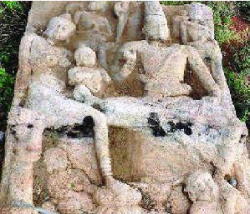
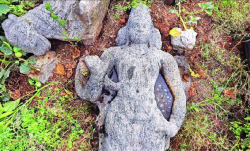 Thatchur - A year ago, when a group of people approached the villagers of Thatchur near Kallakurichi in Villupuram district to construct a temple on an ancient Pallava site, little did they realise that it would be at the cost of some rare 9th century sculptures. Today, the construction of the temple is almost over. But the new structure has taken over the place where the rare sculptures were kept. As a result, a broken shiva linga, a moss-covered Somaskanda panel and many more sculptures are scattered around the temple, covered by grass and almost lost. A committee member of the temple said it was while constructing the temple they removed all the structures and housed them inside a shed. But as the work of the temple progressed, the shed was demolished. Apparently, no one was interested in taking care of the sculptures and they were thrown out. The ruined sculptures, according to Rajasekar, are special in many ways. "There is a beautiful panel of Somaskanda, a form of representation of Shiva with his consort Uma and Skanda on his left. In this panel, you can see Uma and Skanda seated on his right. It's a rare site. There are some inscriptions in 'Vatteluthu'. But the people in the village don't know the value of these sculptures," said Rajasekar.
Thatchur - A year ago, when a group of people approached the villagers of Thatchur near Kallakurichi in Villupuram district to construct a temple on an ancient Pallava site, little did they realise that it would be at the cost of some rare 9th century sculptures. Today, the construction of the temple is almost over. But the new structure has taken over the place where the rare sculptures were kept. As a result, a broken shiva linga, a moss-covered Somaskanda panel and many more sculptures are scattered around the temple, covered by grass and almost lost. A committee member of the temple said it was while constructing the temple they removed all the structures and housed them inside a shed. But as the work of the temple progressed, the shed was demolished. Apparently, no one was interested in taking care of the sculptures and they were thrown out. The ruined sculptures, according to Rajasekar, are special in many ways. "There is a beautiful panel of Somaskanda, a form of representation of Shiva with his consort Uma and Skanda on his left. In this panel, you can see Uma and Skanda seated on his right. It's a rare site. There are some inscriptions in 'Vatteluthu'. But the people in the village don't know the value of these sculptures," said Rajasekar.
http://timesofindia.indiatimes.com/india/Rare-sculptures-thrown-out-as-modern-temple-comes-up-at-ancient-Pallava-site/articleshow/47103523.cms
ROYAUME UNI – 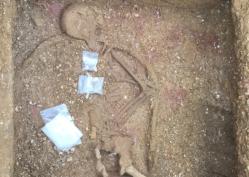 Pocklington - An archeological dig in Pocklington has unearthed a prehistoric man buried with a shield. The skeleton was found in one of the square barrows at the recently discovered Iron Age burial ground on Burnby Lane. MAP Archaeological Practice, the company which is carrying out the excavation work, says it has also discovered a man “of an impressive stature.” The site has so far yielded more than 38 square barrows and in excess of 82 burials. Several of the square barrows contain personal possessions, including jewellery, and a sword has also been discovered.So far the findings have been associated with the Arras culture of the middle to late Iron Age in Eastern Yorkshire.The burial ground is now recognised as being of international importance.
Pocklington - An archeological dig in Pocklington has unearthed a prehistoric man buried with a shield. The skeleton was found in one of the square barrows at the recently discovered Iron Age burial ground on Burnby Lane. MAP Archaeological Practice, the company which is carrying out the excavation work, says it has also discovered a man “of an impressive stature.” The site has so far yielded more than 38 square barrows and in excess of 82 burials. Several of the square barrows contain personal possessions, including jewellery, and a sword has also been discovered.So far the findings have been associated with the Arras culture of the middle to late Iron Age in Eastern Yorkshire.The burial ground is now recognised as being of international importance.
http://www.pocklingtonpost.co.uk/news/local/prehistoric-man-with-shield-found-after-dig-1-7234622
CHINE – Xi'an - China launched a second excavation project on Thursday on a burial pit in the ancient capital of Xi'an, where an army of terra cotta warriors guards the mausoleum of China's first emperor. Archaeologists plan to excavate about 200 square meters of Pit No.2, located near the tomb of Emperor Qinshihuang, founder of the Qin Dynasty (221-206 BC), according to Emperor Qinshihuang's Mausoleum Site Museum. Archaeologist Yuan Zhongyi estimated that the burial pit has 1,400 clay figures and horses and 89 chariots waiting to be unearthed. Yuan described Pit No.2 as "the essence of the terra cotta warriors," for its mix of terra cotta chariots, cavalry and archers. "You can find all the kneeling archers, soldiers and cavalry in the No.2 pit," Yuan said. "Their colorful paint is also relatively well preserved." The No.2 pit was famed for the unearthing of several colorful warriors, including a rare specimen with a green face, indicating that the army was once painted various colors that faded throughout the ages. Located in Xi'an in northwest China's Shaanxi Province, the 56-square-km Mausoleum of Qinshihuang is the world's largest underground mausoleum. An army of more than 7,000 life-sized terra cotta warriors and horses was discovered at the site in 1974. First excavation began on Pit No.2 in 1994 and was halted in 2008 due to a lack of personnel and advanced protective technologies.
http://www.china.org.cn/china/2015-04/30/content_35463711.htm?